Drones are the highly evolved descendants of the RC helicopters and model planes that hobbyists have been flying for decades. What changed? Basically, the rise of smartphones meant a lot of important components — magnetometers, gyros, batteries, cameras, accelerometers, radios, GPS modules, and processors — got a lot smaller and cheaper. Suddenly this wasn’t just a cool toy, but also an aerial camera that could capture amazing angles normally reserved for Hollywood. Add the fact that now you can also pair your drone with the smartphone in your pocket, and today’s units can deliver a ton of advanced capabilities for less than $1,000.
So what makes a great drone? It should be easy to assemble and repair. Since you’ll probably be outside and away from an outlet, battery life is critical. A lot of drones advertise their range, but for the average consumer, durability is way more important — you’re going to crash a lot during the learning process. It needs a good controller that isn’t too complex, and GPS software that will help you to fly in windy conditions. Last but not least, a great drone is going to take some amazing photographs and video.
Unlike Bluetooth speakers or set-top boxes, drones have a really wide range of prices and capabilities. Which drone is best for you kind of depends on what you’re looking to get out of it. But after a few weeks of testing, there is one unit that hovers just above the rest in terms of bang for your buck.
THE WINNER
DJI PHANTOM 2 VISION+
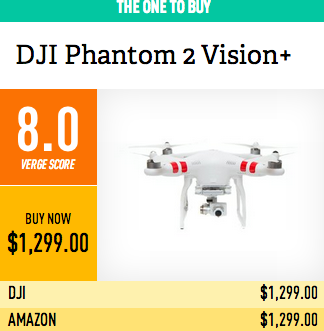 The sleek rounded curves and crisp white body of the DJI Phantom 2 Vision+ would fit in alongside a piece of modernist furniture. And of all the units we tested, the Phantom was the only one that was simultaneously powerful and easy to control. It has built-in GPS that stabilizes the unit against strong winds, something that made a big difference when we were flying it near the beach. Indoors it couldn’t link up with satellites to find its position, but was responsive and stable enough that I managed several indoor flights in tight quarters with only one small crash.
The sleek rounded curves and crisp white body of the DJI Phantom 2 Vision+ would fit in alongside a piece of modernist furniture. And of all the units we tested, the Phantom was the only one that was simultaneously powerful and easy to control. It has built-in GPS that stabilizes the unit against strong winds, something that made a big difference when we were flying it near the beach. Indoors it couldn’t link up with satellites to find its position, but was responsive and stable enough that I managed several indoor flights in tight quarters with only one small crash.
There is a wide range of DJI Phantom 2s available, from the $1,299 Vision 2+, which comes with its own camera, to the $679 Phantom 2, which is probably the best choice if you already have a GoPro handy to attach. Right in the middle is the Phantom 2 Vision, which costs $999 and has a built in camera, but a less flexible attachment.
The rotors and battery both snap into place without a struggle or additional tools. The image quality on the built-in camera was a little worse than what you would get with a GoPro, but the gimbal — basically a self-pivoting support — that comes with the Phantom is a big help in capturing steady footage from the air. You can clip your smartphone to the controller and use that to view the footage you’re capturing live. The battery lasted between 10-15 minutes and takes an hour to charge, so if you’re taking a day trip, it’s best to pack a spare.
The professionals on The Verge’s video team have used this unit to take some incredible footage at high speeds and altitudes, so the fact that I could make it work as a beginner speaks to the Phantom’s amazing range of capability. Learning to fly the Phantom will take a little more work than some of the smaller, cheaper drones on this list, but once you do, it delivers flight performance and video that no other unit can match out of the box.
THE RUNNER UP
PARROT AR DRONE 2.0
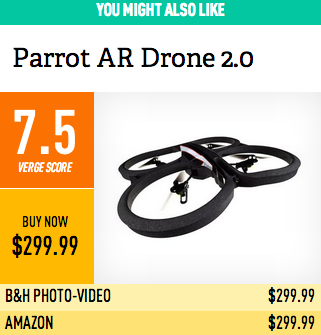 This is probably the consumer drone most people are familiar with — it’s been on the market longer than the rest. And there are definitely some things to love about the AR 2.0. It comes ready to fly, and is controlled with an iPhone app that makes takeoff, calibration, and landing a simple one-tap operation. It has a foam rotor guard, which adds a lot of durability; this was the only unit that didn’t break or lose a rotor during our testing, despite crashing multiple times. The battery charges quickly and isn’t hard to install. And the built-in camera takes decent footage.
This is probably the consumer drone most people are familiar with — it’s been on the market longer than the rest. And there are definitely some things to love about the AR 2.0. It comes ready to fly, and is controlled with an iPhone app that makes takeoff, calibration, and landing a simple one-tap operation. It has a foam rotor guard, which adds a lot of durability; this was the only unit that didn’t break or lose a rotor during our testing, despite crashing multiple times. The battery charges quickly and isn’t hard to install. And the built-in camera takes decent footage.
The major drawback of the AR 2.0 is that you can’t get fine-grained control when you’re using your iPhone to steer. It was good enough for some basic indoor and limited outdoor flight, but certainly nowhere near as quick or precise as the RC controllers we used with other units. The Parrot is cheap, durable, and incredibly easy to start flying. The only big downside is that once you get good, you can’t achieve the flights or footage you could with a DJI Phantom.
THE OTHERS
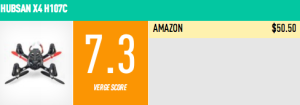 If you’re looking for a unit to learn on, the Hubsan X4 is a great choice. It is powerful enough to handle some light outdoor winds, but small enough not to cause any damage when you crash it indoors. It is prone to losing rotors, so I would recommend buying this with the crash pack, which gives you a bunch of spare rotors and an extra battery for less than $20. The unit also has a built-in camera, which can record video on a microSD card. It takes a bit of work to get the card formatted properly and turning on record mode, capturing a video, and getting the card to store that video, was a haphazard process. When it worked, it shot some funny, if shaky, footage: nothing great, but certainly a nice perk at this price.
If you’re looking for a unit to learn on, the Hubsan X4 is a great choice. It is powerful enough to handle some light outdoor winds, but small enough not to cause any damage when you crash it indoors. It is prone to losing rotors, so I would recommend buying this with the crash pack, which gives you a bunch of spare rotors and an extra battery for less than $20. The unit also has a built-in camera, which can record video on a microSD card. It takes a bit of work to get the card formatted properly and turning on record mode, capturing a video, and getting the card to store that video, was a haphazard process. When it worked, it shot some funny, if shaky, footage: nothing great, but certainly a nice perk at this price.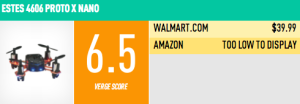 With a body the size of a silver dollar, the Proto X has a sort of cool sci-fi aesthetic, like a micro-bot that James Bond might pull out of his suit pocket. It was easy to charge and handled well indoors, but was too light to counteract most winds outside. Like the Hubsan it was also prone to losing rotors during a crash, and they were even tinier. The battery also never lasted for more than six to seven minutes of solid flying, which isn’t great, since you can’t swap out the battery and need a USB power source to charge. At roughly $40 the Proto X makes a nice stocking stuffer and definitely will help you get your feet wet as a pilot, but isn’t capable of much serious flying or any kind of filming and photography.
With a body the size of a silver dollar, the Proto X has a sort of cool sci-fi aesthetic, like a micro-bot that James Bond might pull out of his suit pocket. It was easy to charge and handled well indoors, but was too light to counteract most winds outside. Like the Hubsan it was also prone to losing rotors during a crash, and they were even tinier. The battery also never lasted for more than six to seven minutes of solid flying, which isn’t great, since you can’t swap out the battery and need a USB power source to charge. At roughly $40 the Proto X makes a nice stocking stuffer and definitely will help you get your feet wet as a pilot, but isn’t capable of much serious flying or any kind of filming and photography.
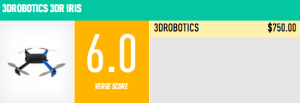 The Iris is meant to be a powerful quadcopter that a beginner can learn on, much like the Phantom. But its build quality and complex controls make it a non-starter for your average first-time pilot. It was a real struggle to get the rotors attached for the first time, and tricky to get the battery locked in place without pinching its loose wires. I managed to get it off the ground only once, and that resulted in a quick and serious crash that broke two of my four rotors. The Iris is for experienced pilots only.
The Iris is meant to be a powerful quadcopter that a beginner can learn on, much like the Phantom. But its build quality and complex controls make it a non-starter for your average first-time pilot. It was a real struggle to get the rotors attached for the first time, and tricky to get the battery locked in place without pinching its loose wires. I managed to get it off the ground only once, and that resulted in a quick and serious crash that broke two of my four rotors. The Iris is for experienced pilots only.
Source: The Verge

You only posted two outlets to buy from but I have had the best results from the company that will provide technical support and repairs. My favorite supplier is atlantahobby.com and I got lousy service from Amazon and had to return it because they did not know how to fix a little software issue.
I bought the Hubsan X4 H107C HD as a fun trainer and started flying it yesterday. I have had numerous crashes and haven’t broken anything on it (yet), though the props have popped off a few times. It’s incredibly durable and a great trainer. I have perhaps 18 flights on it already and took it outdoors today. It definitely can handle light wind, which makes it all the more fun!